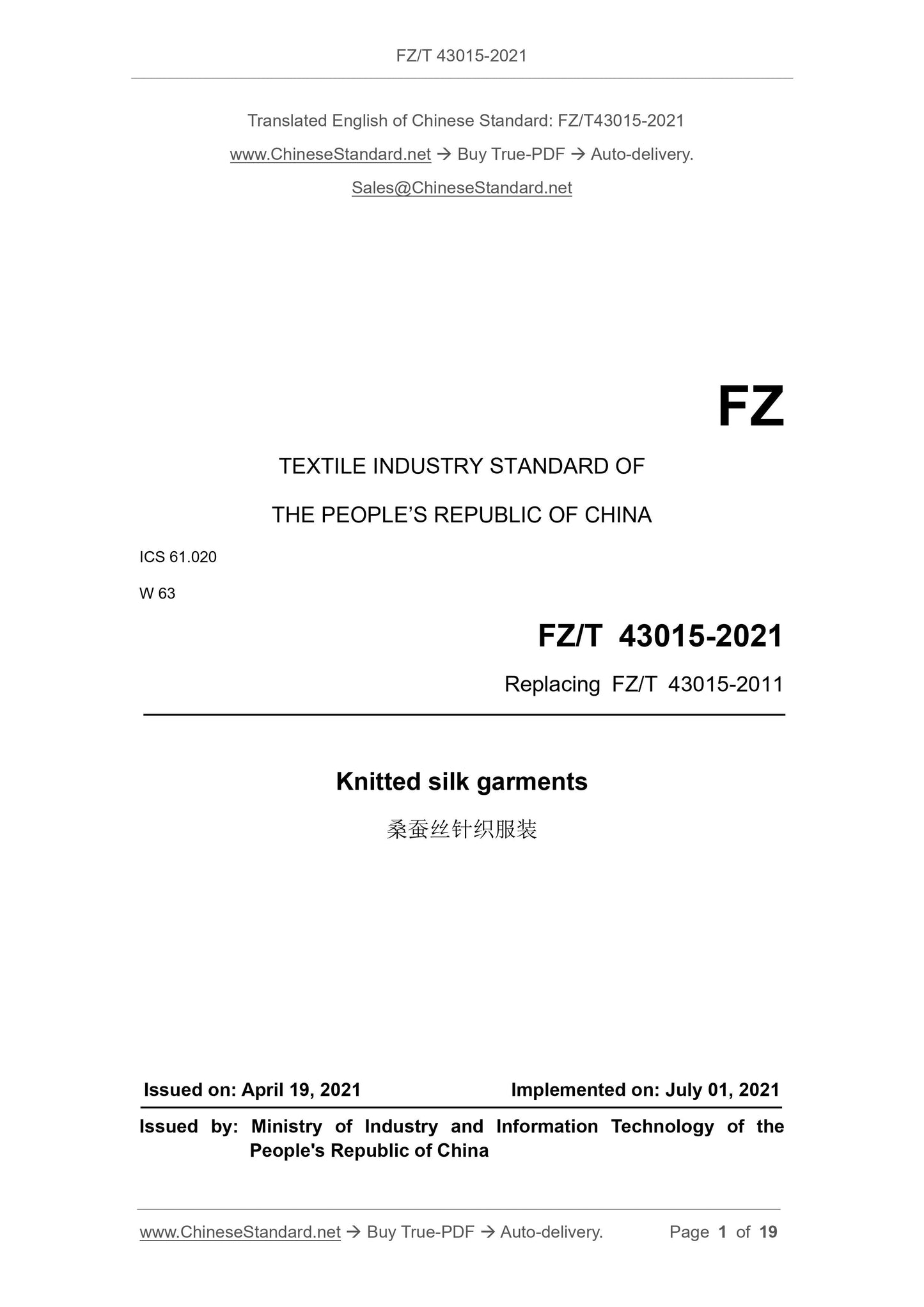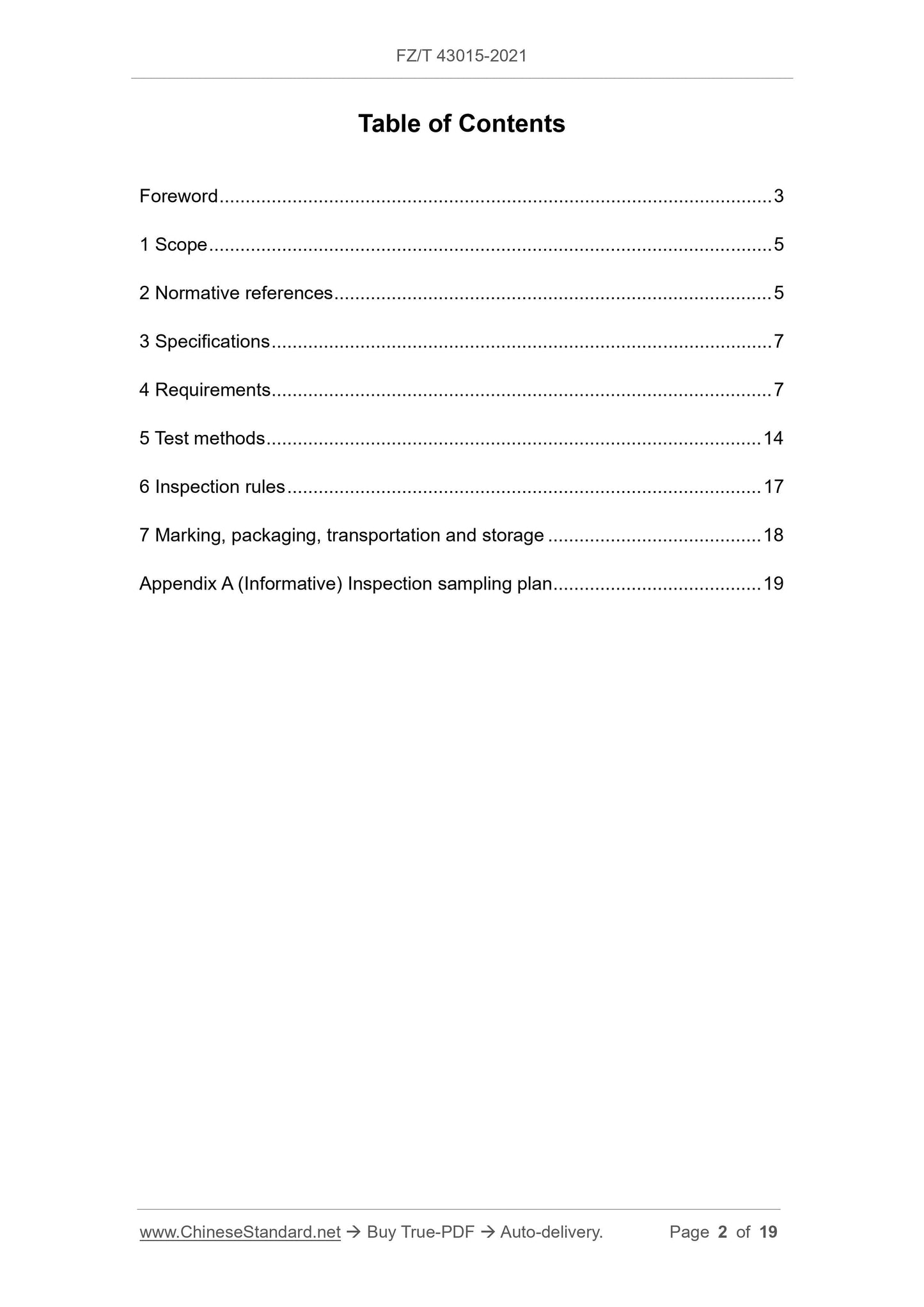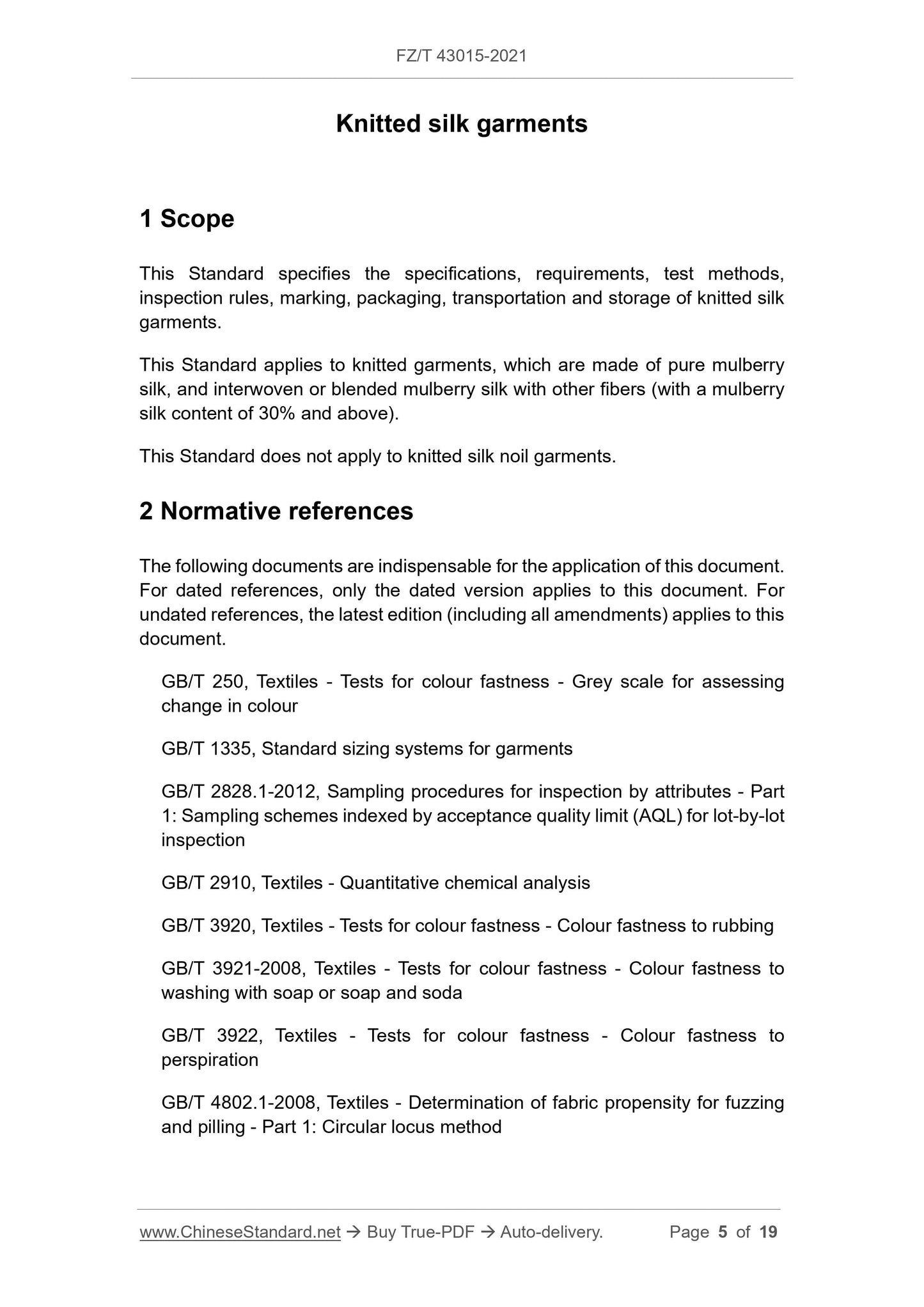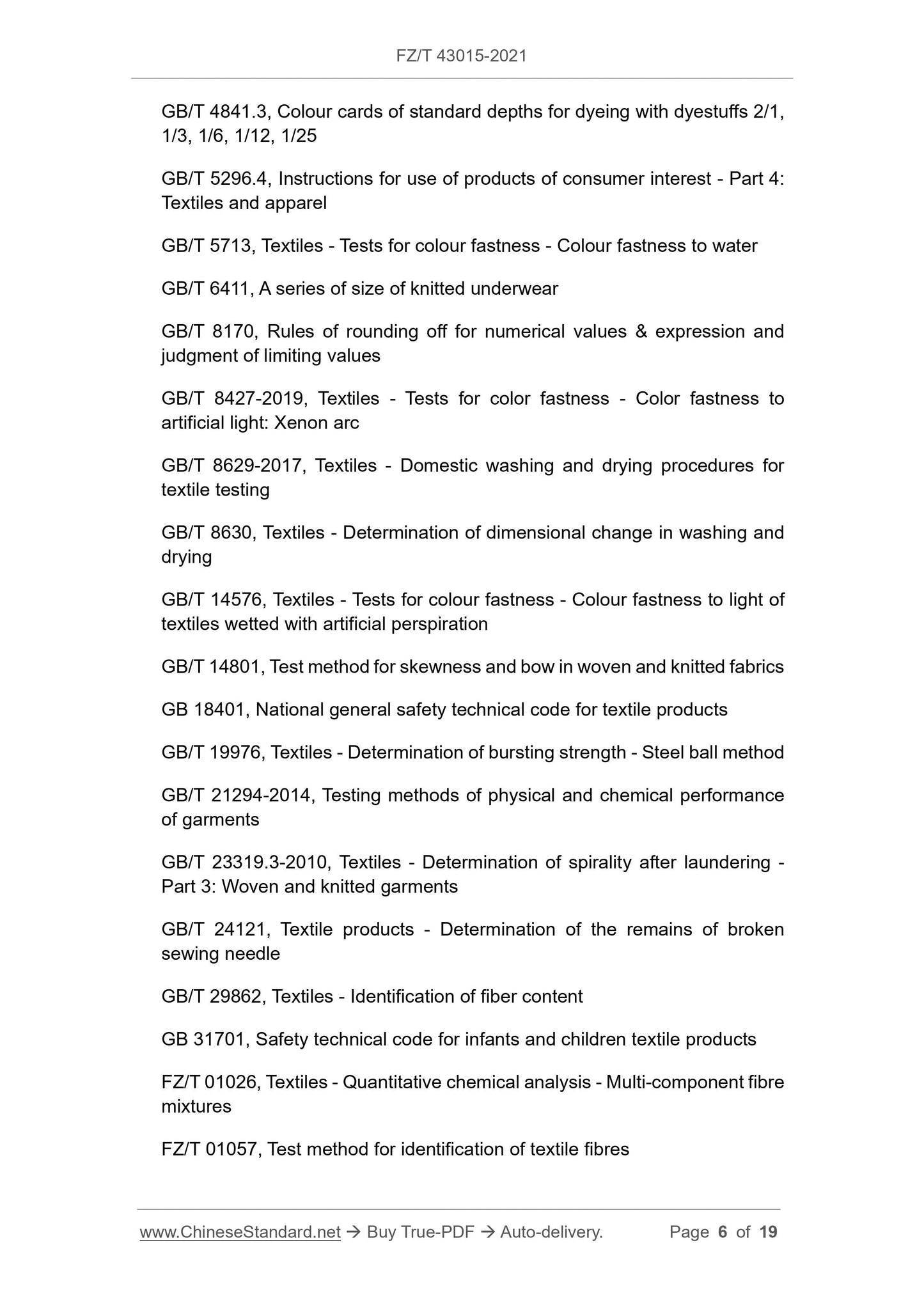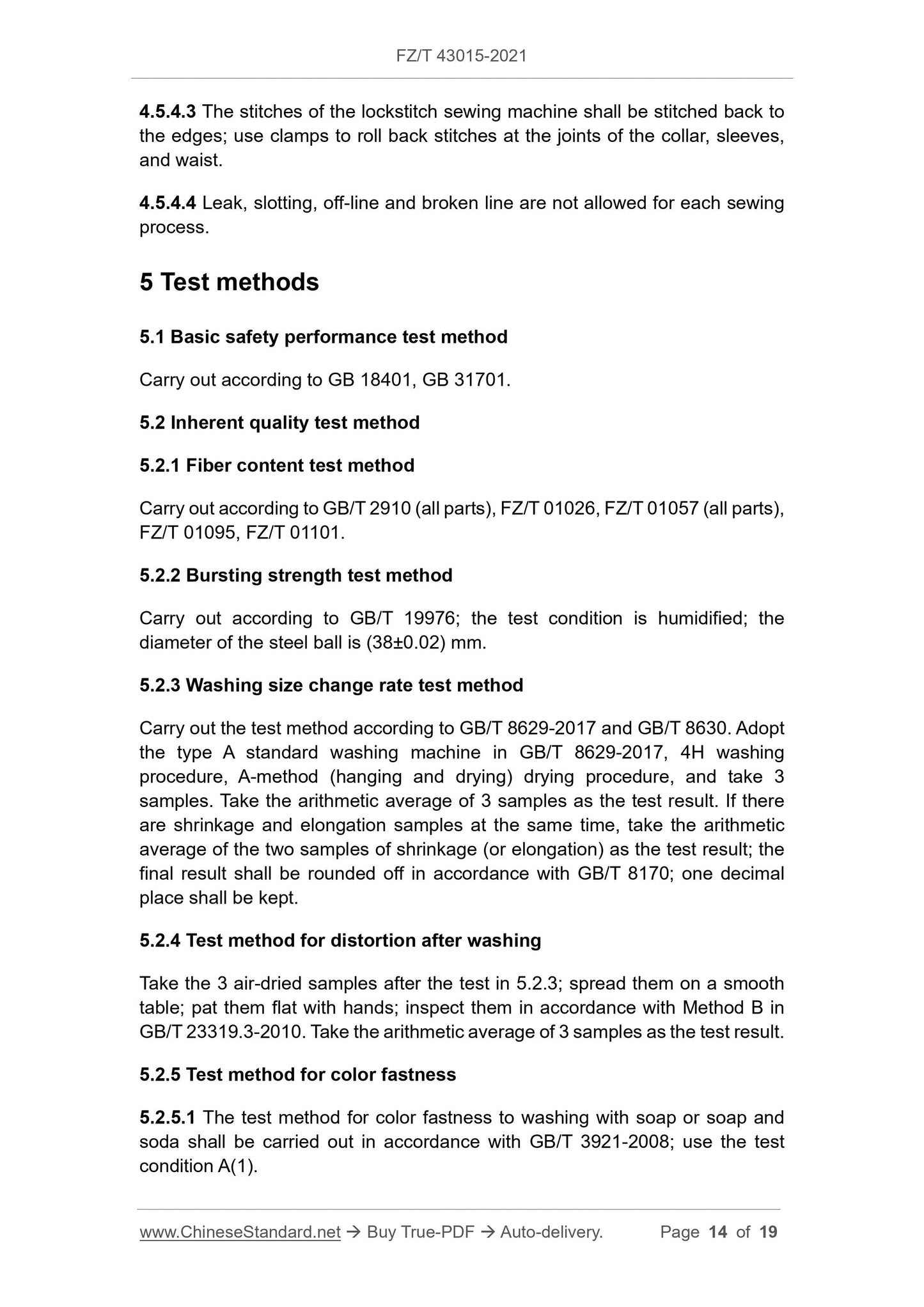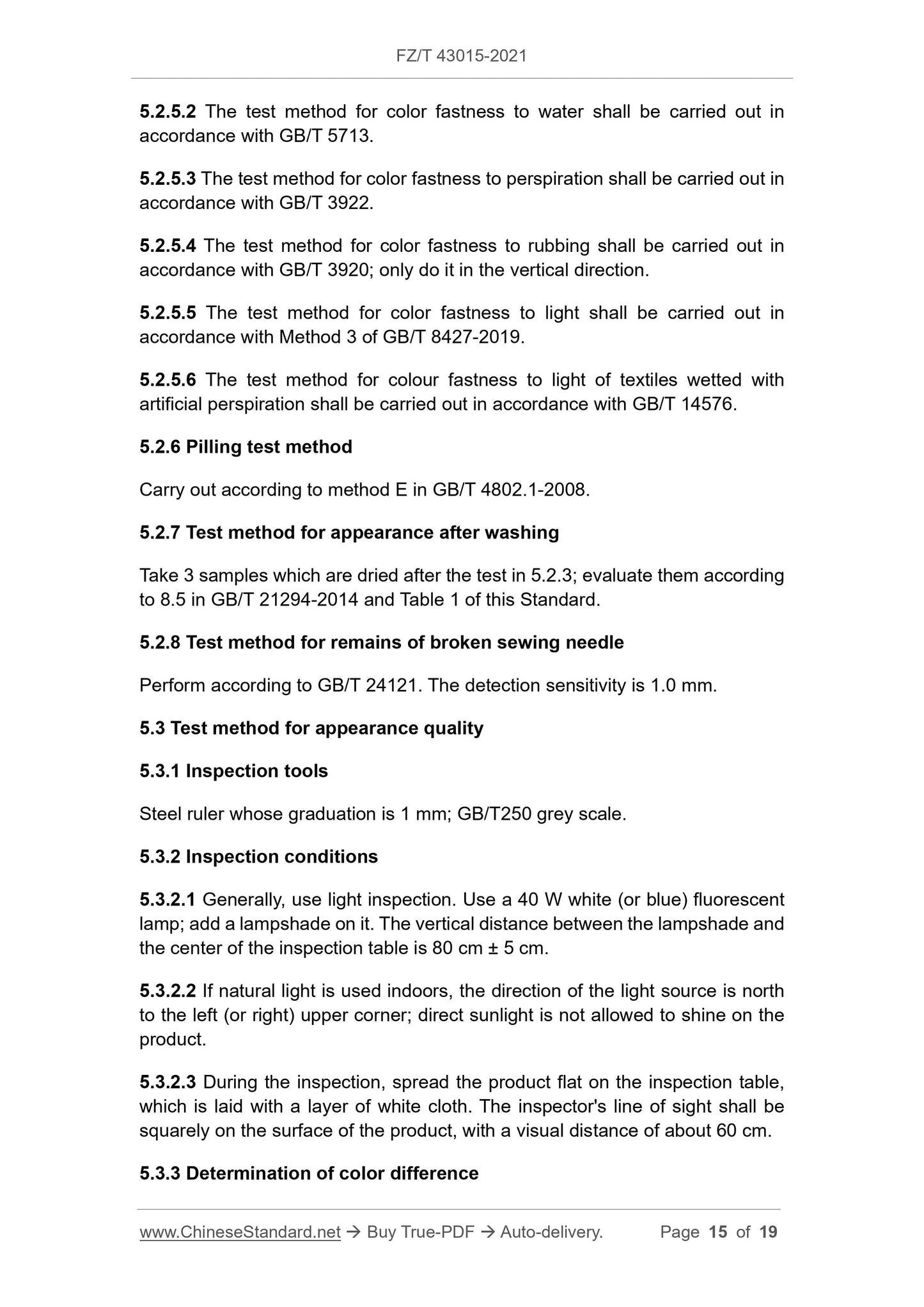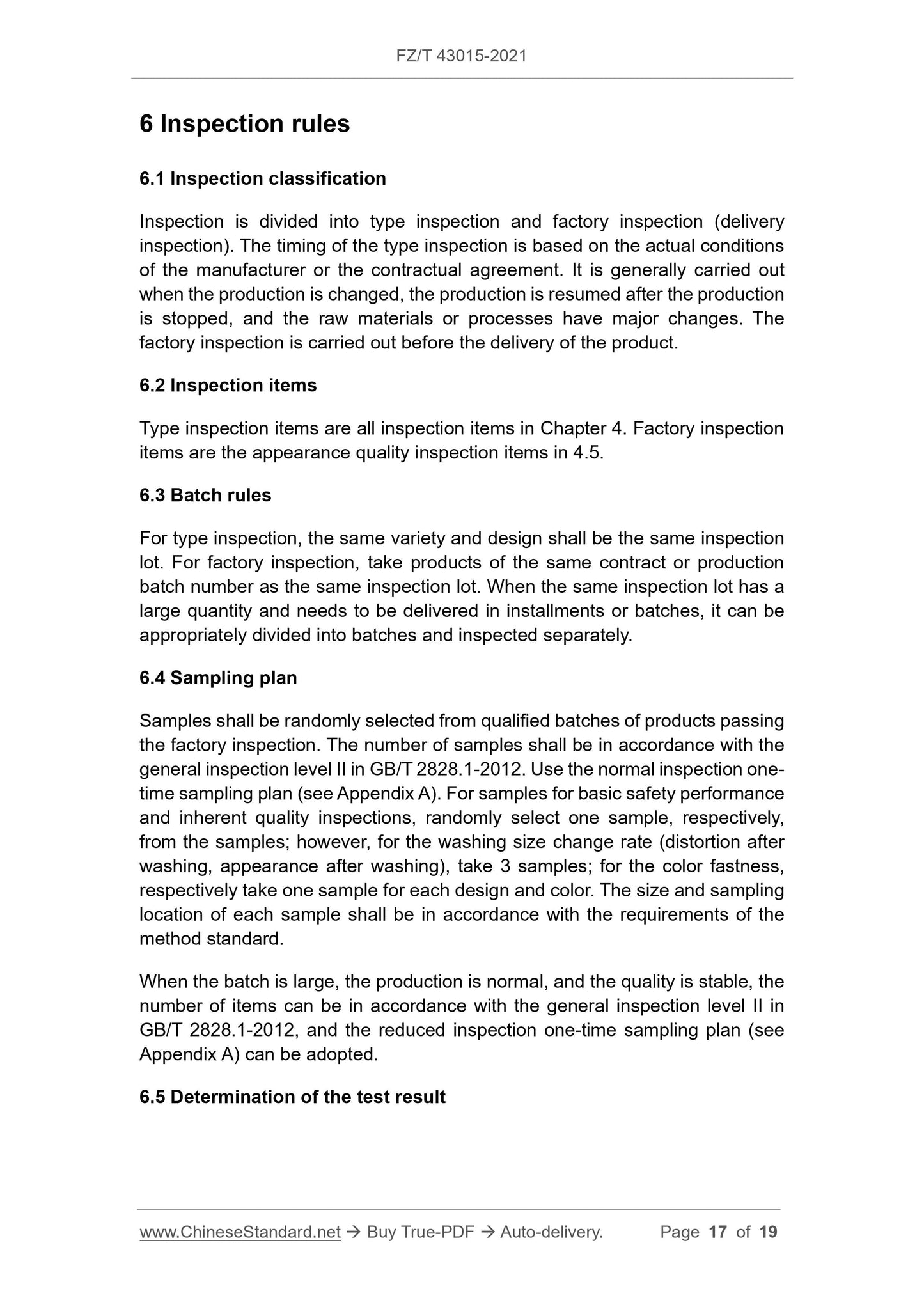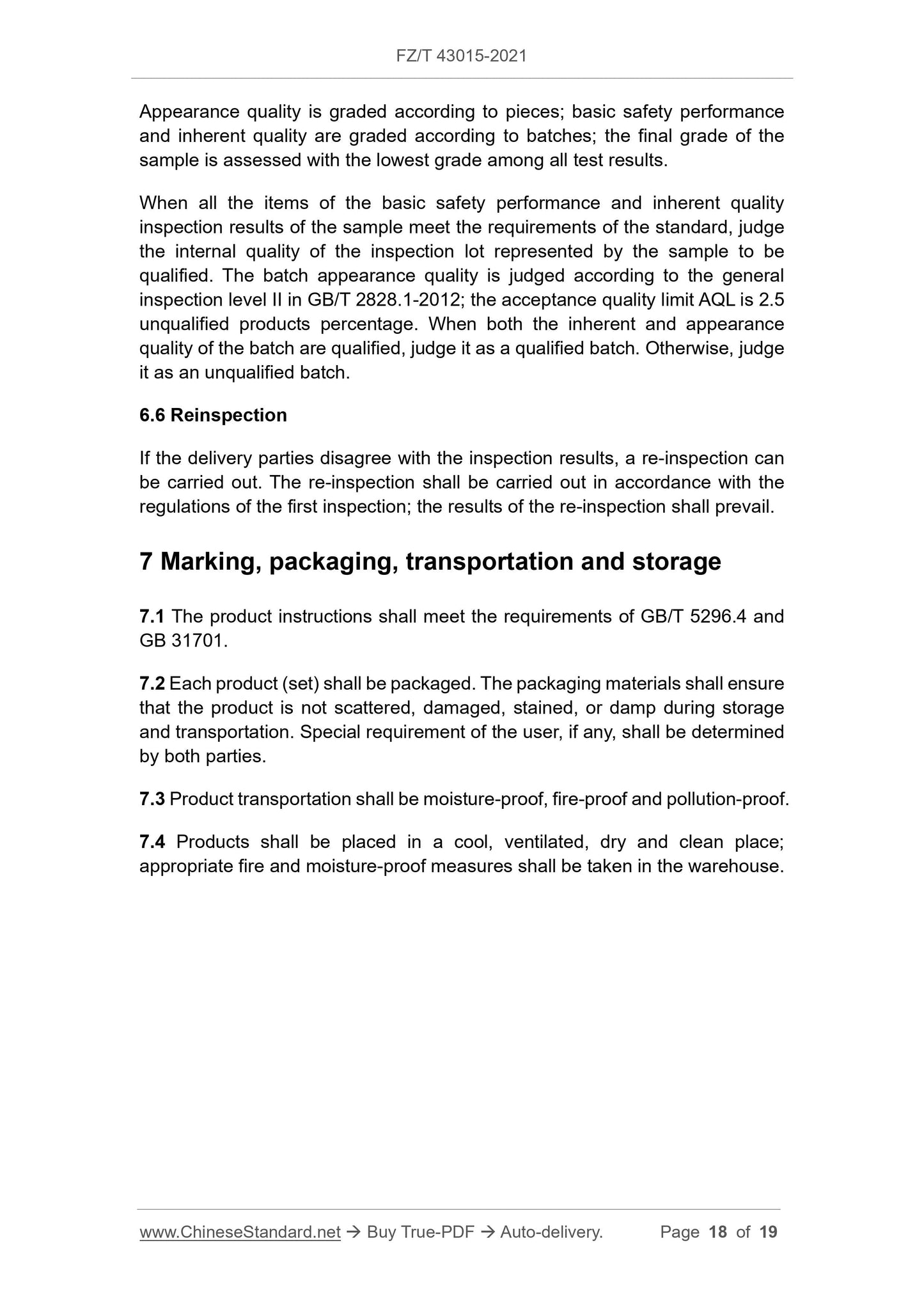1
/
of
8
PayPal, credit cards. Download editable-PDF and invoice in 1 second!
FZ/T 43015-2021 English PDF (FZT43015-2021)
FZ/T 43015-2021 English PDF (FZT43015-2021)
Regular price
$200.00 USD
Regular price
Sale price
$200.00 USD
Unit price
/
per
Shipping calculated at checkout.
Couldn't load pickup availability
Delivery: 3 seconds. Download true-PDF + Invoice.
Get QUOTATION in 1-minute: Click FZ/T 43015-2021
Historical versions: FZ/T 43015-2021
Preview True-PDF (Reload/Scroll if blank)
FZ/T 43015-2021: Knitted silk garments
FZ/T 43015-2021
FZ
TEXTILE INDUSTRY STANDARD OF
THE PEOPLE’S REPUBLIC OF CHINA
ICS 61.020
W 63
Replacing FZ/T 43015-2011
Knitted silk garments
桑蚕丝针织服装
ISSUED ON: APRIL 19, 2021
IMPLEMENTED ON: JULY 01, 2021
Issued by: Ministry of Industry and Information Technology of the
People's Republic of China
Table of Contents
Foreword ... 3
1 Scope ... 5
2 Normative references ... 5
3 Specifications ... 7
4 Requirements ... 7
5 Test methods ... 14
6 Inspection rules ... 17
7 Marking, packaging, transportation and storage ... 18
Appendix A (Informative) Inspection sampling plan ... 19
Knitted silk garments
1 Scope
This Standard specifies the specifications, requirements, test methods,
inspection rules, marking, packaging, transportation and storage of knitted silk
garments.
This Standard applies to knitted garments, which are made of pure mulberry
silk, and interwoven or blended mulberry silk with other fibers (with a mulberry
silk content of 30% and above).
This Standard does not apply to knitted silk noil garments.
2 Normative references
The following documents are indispensable for the application of this document.
For dated references, only the dated version applies to this document. For
undated references, the latest edition (including all amendments) applies to this
document.
GB/T 250, Textiles - Tests for colour fastness - Grey scale for assessing
change in colour
GB/T 1335, Standard sizing systems for garments
GB/T 2828.1-2012, Sampling procedures for inspection by attributes - Part
1: Sampling schemes indexed by acceptance quality limit (AQL) for lot-by-lot
inspection
GB/T 2910, Textiles - Quantitative chemical analysis
GB/T 3920, Textiles - Tests for colour fastness - Colour fastness to rubbing
GB/T 3921-2008, Textiles - Tests for colour fastness - Colour fastness to
washing with soap or soap and soda
GB/T 3922, Textiles - Tests for colour fastness - Colour fastness to
perspiration
GB/T 4802.1-2008, Textiles - Determination of fabric propensity for fuzzing
and pilling - Part 1: Circular locus method
GB/T 4841.3, Colour cards of standard depths for dyeing with dyestuffs 2/1,
1/3, 1/6, 1/12, 1/25
GB/T 5296.4, Instructions for use of products of consumer interest - Part 4:
Textiles and apparel
GB/T 5713, Textiles - Tests for colour fastness - Colour fastness to water
GB/T 6411, A series of size of knitted underwear
GB/T 8170, Rules of rounding off for numerical values and expression and
judgment of limiting values
GB/T 8427-2019, Textiles - Tests for color fastness - Color fastness to
artificial light: Xenon arc
GB/T 8629-2017, Textiles - Domestic washing and drying procedures for
textile testing
GB/T 8630, Textiles - Determination of dimensional change in washing and
drying
GB/T 14576, Textiles - Tests for colour fastness - Colour fastness to light of
textiles wetted with artificial perspiration
GB/T 14801, Test method for skewness and bow in woven and knitted fabrics
GB 18401, National general safety technical code for textile products
GB/T 19976, Textiles - Determination of bursting strength - Steel ball method
GB/T 21294-2014, Testing methods of physical and chemical performance
of garments
GB/T 23319.3-2010, Textiles - Determination of spirality after laundering -
Part 3: Woven and knitted garments
GB/T 24121, Textile products - Determination of the remains of broken
sewing needle
GB/T 29862, Textiles - Identification of fiber content
GB 31701, Safety technical code for infants and children textile products
FZ/T 01026, Textiles - Quantitative chemical analysis - Multi-component fibre
mixtures
FZ/T 01057, Test method for identification of textile fibres
4.5.4.3 The stitches of the lockstitch sewing machine shall be stitched back to
the edges; use clamps to roll back stitches at the joints of the collar, sleeves,
and waist.
4.5.4.4 Leak, slotting, off-line and broken line are not allowed for each sewing
process.
5 Test methods
5.1 Basic safety performance test method
Carry out according to GB 18401, GB 31701.
5.2 Inherent quality test method
5.2.1 Fiber content test method
Carry out according to GB/T 2910 (all parts), FZ/T 01026, FZ/T 01057 (all parts),
FZ/T 01095, FZ/T 01101.
5.2.2 Bursting strength test method
Carry out according to GB/T 19976; the test condition is humidified; the
diameter of the steel ball is (38±0.02) mm.
5.2.3 Washing size change rate test method
Carry out the test method according to GB/T 8629-2017 and GB/T 8630. Adopt
the type A standard washing machine in GB/T 8629-2017, 4H washing
procedure, A-method (hanging and drying) drying procedure, and take 3
samples. Take the arithmetic average of 3 samples as the test result. If there
are shrinkage and elongation samples at the same time, take the arithmetic
average of the two samples of shrinkage (or elongation) as the test result; the
final result shall be rounded off in accordance with GB/T 8170; one decimal
place shall be kept.
5.2.4 Test method for distortion after washing
Take the 3 air-dried samples after the test in 5.2.3; spread them on a smooth
table; pat them flat with hands; inspect them in accordance with Method B in
GB/T 23319.3-2010. Take the arithmetic average of 3 samples as the test result.
5.2.5 Test method for color fastness
5.2.5.1 The test method for color fastness to washing with soap or soap and
soda shall be carried out in accordance with GB/T 3921-2008; use the test
condition A(1).
5.2.5.2 The test method for color fastness to water shall be carried out in
accordance with GB/T 5713.
5.2.5.3 The test method for color fastness to perspiration shall be carried out in
accordance with GB/T 3922.
5.2.5.4 The test method for color fastness to rubbing shall be carried out in
accordance with GB/T 3920; only do it in the vertical direction.
5.2.5.5 The test method for color fastness to light shall be carried out in
accordance with Method 3 of GB/T 8427-2019.
5.2.5.6 The test method for colour fastness to light of textiles wetted with
artificial perspiration shall be carried out in accordance with GB/T 14576.
5.2.6 Pilling test method
Carry out according to method E in GB/T 4802.1-2008.
5.2.7 Test method for appearance after washing
Take 3 samples which are dried after the test in 5.2.3; evaluate them according
to 8.5 in GB/T 21294-2014 and Table 1 of this Standard.
5.2.8 Test method for remains of broken sewing needle
Perform according to GB/T 24121. The detection sensitivity is 1.0 mm.
5.3 Test method for appearance quality
5.3.1 Inspection tools
Steel ruler whose graduation is 1 mm; GB/T250 grey scale.
5.3.2 Inspection conditions
5.3.2.1 Generally, use light inspection. Use a 40 W white (or blue) fluorescent
lamp; add a lampshade on it. The vertical distance between the lampshade and
the center of the inspection table is 80 cm ± 5 cm.
5.3.2.2 If natural light is used indoors, the direction of the light source is north
to the left (or right) upper corner; direct sunlight is not allowed to shine on the
product.
5.3.2.3 During the inspection, spread the product flat on the inspection table,
which is laid with a layer of white cloth. The inspector's line of sight shall be
squarely on the surface of the product, with a visual distance of about 60 cm.
5.3.3 Determination of color difference
6 Inspection rules
6.1 Inspection classification
Inspect...
Get QUOTATION in 1-minute: Click FZ/T 43015-2021
Historical versions: FZ/T 43015-2021
Preview True-PDF (Reload/Scroll if blank)
FZ/T 43015-2021: Knitted silk garments
FZ/T 43015-2021
FZ
TEXTILE INDUSTRY STANDARD OF
THE PEOPLE’S REPUBLIC OF CHINA
ICS 61.020
W 63
Replacing FZ/T 43015-2011
Knitted silk garments
桑蚕丝针织服装
ISSUED ON: APRIL 19, 2021
IMPLEMENTED ON: JULY 01, 2021
Issued by: Ministry of Industry and Information Technology of the
People's Republic of China
Table of Contents
Foreword ... 3
1 Scope ... 5
2 Normative references ... 5
3 Specifications ... 7
4 Requirements ... 7
5 Test methods ... 14
6 Inspection rules ... 17
7 Marking, packaging, transportation and storage ... 18
Appendix A (Informative) Inspection sampling plan ... 19
Knitted silk garments
1 Scope
This Standard specifies the specifications, requirements, test methods,
inspection rules, marking, packaging, transportation and storage of knitted silk
garments.
This Standard applies to knitted garments, which are made of pure mulberry
silk, and interwoven or blended mulberry silk with other fibers (with a mulberry
silk content of 30% and above).
This Standard does not apply to knitted silk noil garments.
2 Normative references
The following documents are indispensable for the application of this document.
For dated references, only the dated version applies to this document. For
undated references, the latest edition (including all amendments) applies to this
document.
GB/T 250, Textiles - Tests for colour fastness - Grey scale for assessing
change in colour
GB/T 1335, Standard sizing systems for garments
GB/T 2828.1-2012, Sampling procedures for inspection by attributes - Part
1: Sampling schemes indexed by acceptance quality limit (AQL) for lot-by-lot
inspection
GB/T 2910, Textiles - Quantitative chemical analysis
GB/T 3920, Textiles - Tests for colour fastness - Colour fastness to rubbing
GB/T 3921-2008, Textiles - Tests for colour fastness - Colour fastness to
washing with soap or soap and soda
GB/T 3922, Textiles - Tests for colour fastness - Colour fastness to
perspiration
GB/T 4802.1-2008, Textiles - Determination of fabric propensity for fuzzing
and pilling - Part 1: Circular locus method
GB/T 4841.3, Colour cards of standard depths for dyeing with dyestuffs 2/1,
1/3, 1/6, 1/12, 1/25
GB/T 5296.4, Instructions for use of products of consumer interest - Part 4:
Textiles and apparel
GB/T 5713, Textiles - Tests for colour fastness - Colour fastness to water
GB/T 6411, A series of size of knitted underwear
GB/T 8170, Rules of rounding off for numerical values and expression and
judgment of limiting values
GB/T 8427-2019, Textiles - Tests for color fastness - Color fastness to
artificial light: Xenon arc
GB/T 8629-2017, Textiles - Domestic washing and drying procedures for
textile testing
GB/T 8630, Textiles - Determination of dimensional change in washing and
drying
GB/T 14576, Textiles - Tests for colour fastness - Colour fastness to light of
textiles wetted with artificial perspiration
GB/T 14801, Test method for skewness and bow in woven and knitted fabrics
GB 18401, National general safety technical code for textile products
GB/T 19976, Textiles - Determination of bursting strength - Steel ball method
GB/T 21294-2014, Testing methods of physical and chemical performance
of garments
GB/T 23319.3-2010, Textiles - Determination of spirality after laundering -
Part 3: Woven and knitted garments
GB/T 24121, Textile products - Determination of the remains of broken
sewing needle
GB/T 29862, Textiles - Identification of fiber content
GB 31701, Safety technical code for infants and children textile products
FZ/T 01026, Textiles - Quantitative chemical analysis - Multi-component fibre
mixtures
FZ/T 01057, Test method for identification of textile fibres
4.5.4.3 The stitches of the lockstitch sewing machine shall be stitched back to
the edges; use clamps to roll back stitches at the joints of the collar, sleeves,
and waist.
4.5.4.4 Leak, slotting, off-line and broken line are not allowed for each sewing
process.
5 Test methods
5.1 Basic safety performance test method
Carry out according to GB 18401, GB 31701.
5.2 Inherent quality test method
5.2.1 Fiber content test method
Carry out according to GB/T 2910 (all parts), FZ/T 01026, FZ/T 01057 (all parts),
FZ/T 01095, FZ/T 01101.
5.2.2 Bursting strength test method
Carry out according to GB/T 19976; the test condition is humidified; the
diameter of the steel ball is (38±0.02) mm.
5.2.3 Washing size change rate test method
Carry out the test method according to GB/T 8629-2017 and GB/T 8630. Adopt
the type A standard washing machine in GB/T 8629-2017, 4H washing
procedure, A-method (hanging and drying) drying procedure, and take 3
samples. Take the arithmetic average of 3 samples as the test result. If there
are shrinkage and elongation samples at the same time, take the arithmetic
average of the two samples of shrinkage (or elongation) as the test result; the
final result shall be rounded off in accordance with GB/T 8170; one decimal
place shall be kept.
5.2.4 Test method for distortion after washing
Take the 3 air-dried samples after the test in 5.2.3; spread them on a smooth
table; pat them flat with hands; inspect them in accordance with Method B in
GB/T 23319.3-2010. Take the arithmetic average of 3 samples as the test result.
5.2.5 Test method for color fastness
5.2.5.1 The test method for color fastness to washing with soap or soap and
soda shall be carried out in accordance with GB/T 3921-2008; use the test
condition A(1).
5.2.5.2 The test method for color fastness to water shall be carried out in
accordance with GB/T 5713.
5.2.5.3 The test method for color fastness to perspiration shall be carried out in
accordance with GB/T 3922.
5.2.5.4 The test method for color fastness to rubbing shall be carried out in
accordance with GB/T 3920; only do it in the vertical direction.
5.2.5.5 The test method for color fastness to light shall be carried out in
accordance with Method 3 of GB/T 8427-2019.
5.2.5.6 The test method for colour fastness to light of textiles wetted with
artificial perspiration shall be carried out in accordance with GB/T 14576.
5.2.6 Pilling test method
Carry out according to method E in GB/T 4802.1-2008.
5.2.7 Test method for appearance after washing
Take 3 samples which are dried after the test in 5.2.3; evaluate them according
to 8.5 in GB/T 21294-2014 and Table 1 of this Standard.
5.2.8 Test method for remains of broken sewing needle
Perform according to GB/T 24121. The detection sensitivity is 1.0 mm.
5.3 Test method for appearance quality
5.3.1 Inspection tools
Steel ruler whose graduation is 1 mm; GB/T250 grey scale.
5.3.2 Inspection conditions
5.3.2.1 Generally, use light inspection. Use a 40 W white (or blue) fluorescent
lamp; add a lampshade on it. The vertical distance between the lampshade and
the center of the inspection table is 80 cm ± 5 cm.
5.3.2.2 If natural light is used indoors, the direction of the light source is north
to the left (or right) upper corner; direct sunlight is not allowed to shine on the
product.
5.3.2.3 During the inspection, spread the product flat on the inspection table,
which is laid with a layer of white cloth. The inspector's line of sight shall be
squarely on the surface of the product, with a visual distance of about 60 cm.
5.3.3 Determination of color difference
6 Inspection rules
6.1 Inspection classification
Inspect...
Share
